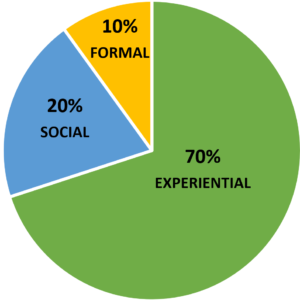
Have you ever sat through a particularly boring movie and thought, “I’ve seen this before.” Why do people create something following the same bad format? That’s because making something truly original that breaks the mold can be challenging…but we can all agree that the end result is worth it.
As we come to the end of this four-part series, we conclude our examination of 70-20-10 (the framework consisting of 70% applied learning, coaching and mentoring, 20% social learning, and 10% formal learning) as a guide, rather than a rule. Sometimes, the experience you are wanting to create demands a different mix. Maybe 30-30-40 is best for what you are trying to accomplish. As learning professionals, it is our job to help identify the right mix for the circumstance or need but most certainly each dimension should be part of the solution mix.
While formal learning is often necessary for foundational knowledge and skills, it is often the most costly of the 70-20-10 mix. Imagine that we pay people to work and within that context 70 and 20 are happening without added expense – it is organic. Now there is a compelling case for developing leaders to foster a culture of continuous learning.
Typically, the hardest conversations learning professionals have when recommending solutions is in the execution of the 70%. This is where our consultative guidance can help make the difference between dismal and exceptional performance results. 70 and 20 are essential for continuous improvement and development. In some lucky organizations, all or some of these happen organically within the work culture. For other organizations, they need to intentionally focus on creating this continuous learning environment and help leaders understand the importance of their role in fostering a continuous learning culture. If there aren’t people leaders fulfilling this role as a component of the learning spectrum from novice to expert, then we get less than 100% of the 70-20-10 model.
While 70-20-10 can be a handy guide to remind us of the ways that individuals process new information, the learners’ experience and needs should be the factors behind any learning strategy. Just as people don’t like to be in a box, our solutions for their development can never be one-size-fits-all. Whatever the ratio a particular organization needs, it’s the resources, structure and support that make the strategy successful.
As a learning and development professional, you are the director of this movie. Don’t take the easy road by following the same clichéd plot as everyone else. Customize services to every single one of your clients, and the end result will be Oscar-worthy. Now CUT…that’s a wrap!




